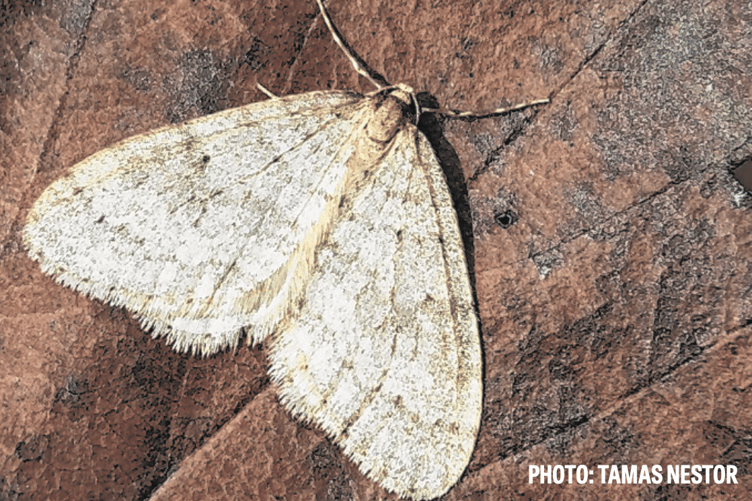Have you spotted any moths fluttering at night-time recently? If so they are probably one of the three species active at this time of year, including the aptly named December Moth and Winter Moth.
The December Moth can be spotted on the wing over much of Britain in November and December. It is fully kitted up for the winter weather with its thick body and a coat of long hair-like scales which help keep it warm when the temperatures drop.
The December Moth flies at night and is attracted to light. It is mainly found in woodland but also in scrub, hedgerows and gardens. Its forewings are charcoal grey-brown in colour with wavy creamy white markings. The wingspan is from 30mm to 45mm, the females being much larger than the males.
The adult moths are not able to feed and spend their time searching for a mate. The female lays eggs during December under the bark of broadleaved trees including oak, birch, elms, hawthorn and blackthorn. The eggs will not hatch until the spring when they feed on the leaves of the host trees.
The Winter Moth takes a different approach to the December Moth – no fluffy coat, no thick body. However, it still braves the elements to fly at night between October and January. It too is attracted to light.
Unlike other moths which need to warm their bodies to over 30 degrees Celsius to fly, the Winter Moth seems to use its unusually low body weight compared to the size of its wings to its advantage and can fly even when its body temperature is close to ambient.
The Winter Moth is a medium-sized moth, with a wingspan range from 22mm to 28mm. It can be found in all habitats. The males and females look very different, as the wings on females are little more than short nubs. Rather than fly about in search of a mate, they produce pheromones and wait for the males to come to them.
Eggs are laid on twigs or in cracks in the bark of various broadleaved trees and shrubs, where they spend the rest of the winter.
The caterpillars hatch in the spring as the buds are opening, then feed on the foliage. They can “balloon” from tree to tree by spinning a silk thread and using the breeze to carry them along to the next food source. In early June the caterpillars fall to the ground to pupate.
Great tits and blue tits feed their young on Winter Moth caterpillars and will time their breeding to coincide with the moth’s lifecycle.
The Mottled Umber is another common brown moth at this time of year in suburban areas as well as woodlands. It is common over most of Britain, especially here in the south.
The females of this species are completely wingless, while the males have wings which are variable in appearance: the wings of some are mainly brown but many have distinctive brown bands on a lighter brown background and a dark spot on each wing. The wingspan is from 30mm to 40mm. The males are attracted to light.
Mottled Umber caterpillars feed on broad-leaved trees and shrubs, including oak, birch, hazel, hawthorn, blackthorn, apple, dog-rose, sycamore, hornbeam and elm. It too overwinters as an egg.
If you are interested in moths you will find lots of information online. The following are good places to start:
* The website https://ukmoths.org.uk is built, run and maintained by a moth enthusiast, Ian Kimber, with contributions of photos and information from other enthusiasts.
* The Butterfly Conservation charity’s website https://butterfly-conservation.org has lots of information on moths as well as butterflies.
* A series of specialist county-specific websites about moths, all designed and developed by Jim Wheeler, are indexed at https://lepidoptera.uk





Comments
This article has no comments yet. Be the first to leave a comment.